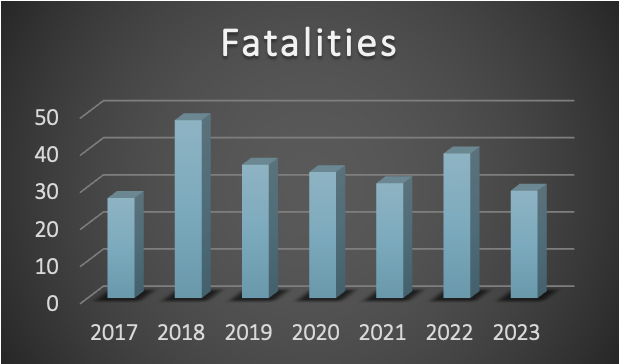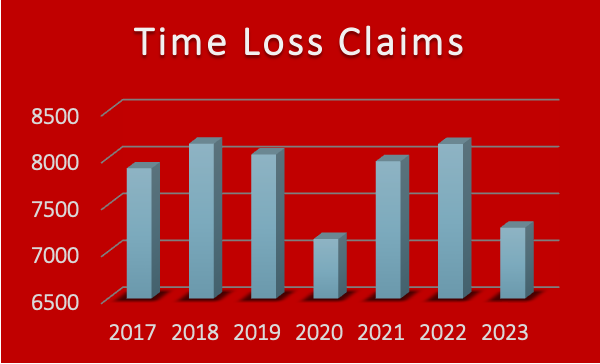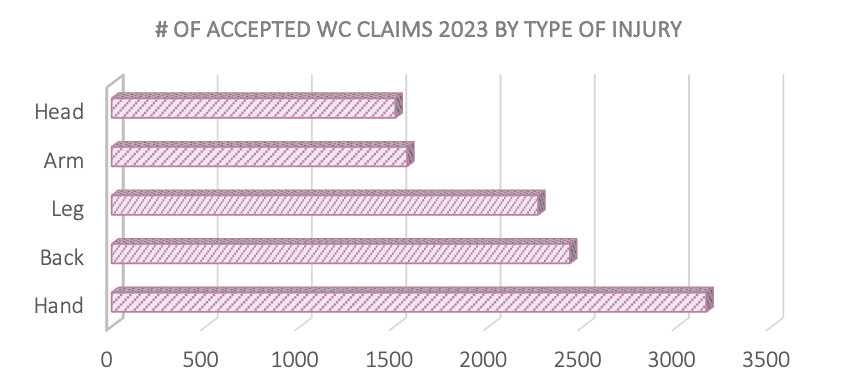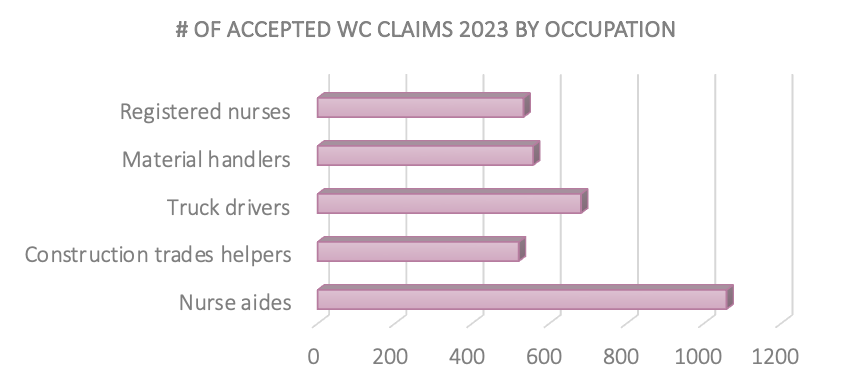(8) Session 10 - Regulating Occupational Health & Safety (OHS) And Worker’s Compensation
OHS Overview
Occupational Health and Safety (OHS): Commonly referred to as "occupational health and safety," OHS aims to reduce workplace deaths and injuries.
History: OHS initiatives began over 130 years ago as efforts to minimize workplace deaths and injuries.
Internal Shared Responsibility: OHS is considered a shared responsibility between employees and employers, forming what is known as the internal responsibility system.
Relevance Post-COVID: The field of OHS is emerging as crucial, particularly in areas of people analytics, reflecting its increased importance post-Covid.
Key Pillars of OHS:
Commitment by Leadership/Management: Leaders are expected to actively support and engage in OHS practices ("Walk the talk").
Employee Participation: Employee involvement in OHS initiatives is vital for their success.
Healthy Work Environment: Compliance with OHS-related legislation is essential to create a safe work environment.
Tailored Initiatives: It's important to recognize that OHS initiatives should be customized to fit specific workplace environments; there is no "one size fits all" solution.
WHMIS - What?
Definition: WHMIS stands for Workplace Hazardous Material Information System.
Purpose: Established by the federal government as a national standard, WHMIS classifies different classes of hazardous materials such as flammable, poisonous, corrosive, and dangerously reactive materials.
Regulatory Flexibility: It allows different jurisdictions to define their own specific requirements regarding the labeling, storage, disposal, and handling of hazardous materials.
OHS - Basic Legal Principles
Sources of OHS Law
Federal: The Canada Labour Code (Part II) governs occupational health and safety at the federal level.
Provincial: In Saskatchewan, the Saskatchewan Employment Act (Part III) addresses provincial OHS concerns.
Regulations and Specific Laws: There are various regulations supplementing the main OHS-related laws, as well as numerous industry-specific laws, such as the Transportation of Dangerous Goods Act.
Basic Principles of OHS Laws
Employer Obligation: Employers must take every reasonable precaution to ensure the workplace is safe. This does not imply that workplaces must be completely risk-free.
Employee Obligation: Employees are required to comply with OHS laws and any safety directions established by their employer.
Employee Rights:
Participate: Employees have the right to participate in joint health and safety committees.
Know: Employees have the right to know about workplace hazards, including information under WHMIS and occupational exposure limits for hazardous substances.
Refuse Unsafe Work: Employees have the right to refuse unsafe work, although this right is not often exercised.
Enforcement of the Law
Complaints and Investigations: Enforcement is typically initiated through proactive government enforcement or individual complaints, which usually trigger an investigation.
Consequences for Non-Compliance: Non-compliance by employers can lead to fines, the shutting down of workplaces, and in rare cases, jail time.
Criminal Prosecution: The Criminal Code allows for the prosecution of corporations for incidents resulting in death or injury at the workplace, although this is rarely done in practice.
Worker’s Compensation (WC): Context
Overview
Regulation: Worker’s Compensation is regulated at the provincial/territorial level with different regulations across Canada.
Establishment: The system was established in Saskatchewan in 1911.
Purpose: It provides benefits to employees who are injured at work or to survivors if the employee is killed at work. The system operates on a no-fault insurance basis, protecting employers from lawsuits while ensuring employees receive reasonable compensation for lost earnings, as well as medical treatment and rehabilitation.
5 Cornerstones of WC (Meredith Principles) - apply in all jurisdictions
No-fault Compensation: Parties waive the right to sue, which eliminates disputes over responsibility for injuries.
Collective Liability: Costs are shared among employers without employee contributions.
Exclusive Jurisdiction: The Worker’s Compensation Board acts as the final decision-maker and is not bound by legal precedent, ensuring decisions are tailored to specific cases.
Security of Payment: A fund guarantees that compensation will always be available for employees, providing financial security and reassurance.
Independent Board: The board is autonomous, non-political, and financially independent of the government, which helps in maintaining its impartiality.
OHS - The Data for Saskatchewan (SK)
Fatalities

The graph displays a trend in workplace fatalities from 2017 to 2023. It shows a slight decline over the years, with a notable decrease in 2023 compared to 2022.
Time Loss Claims

This graph shows the number of time loss claims from 2017 to 2023. After a peak in 2020, there has been a general decline, suggesting improvements in workplace safety or claims management.
Long-term Trends
Motor Vehicle Crashes: From 2011 to 2020, motor vehicle crashes were the #1 cause of fatalities in the workplace.
Asbestos-Related Diseases: 72% of disease fatalities between 2011 and 2020 were related to asbestos.
Top Industries for Serious Injuries in 2023: The health care, transportation, and construction industries were highlighted as having the highest rates of serious injuries.
Worker's Compensation Claims in 2023
By Type of Injury:

Injuries to the hand were the most frequently reported, followed by back, leg, arm, and head injuries.
By Occupation:

Registered nurses filed the most claims, followed by material handlers, truck drivers, construction trades helpers, and nurse aides.
Workers Compensation: Key Design Features
Key Features of Worker's Compensation
Immunity from Lawsuit: Provides immunity from lawsuits for the employer/worker, but not for third parties.
Fair Compensation: Ensures fair compensation for injured workers and fair premium rates for employers.
Benefit of Doubt: In claims adjudication, the benefit of the doubt is often given to the worker.
Comprehensive Prevention and Management: Includes comprehensive injury prevention and disability management strategies.
Long-term Stability: Focuses on long-term stability, financial security, and cost-effectiveness of the compensation system.
Responsibilities of WC Boards
Non-Profit Operation: WC Boards operate on a non-profit basis.
System Administration: Responsible for the administration of the worker’s compensation system.
Contributions and Benefits: Manages the collection of contributions and the payment of benefits.
Claims Adjudication: Handles the adjudication of claims and dispute resolution.
Types of Injuries Covered
Traumatic Injuries: Such as broken bones.
Repetitive Stress Injuries: Such as tendonitis.
Occupational Diseases: Including respiratory problems caused by exposure to chemicals.
Reinjuries and Complications: Covering reinjury and difficulties with a previous work-related injury.
Legislation (SK) and Funding
System Funding and Operation
Funding: The system is funded solely by employer contributions.
Assessment Rates: Assessment rates are determined by the Worker’s Compensation Board of each jurisdiction.
Participation: Participation in the system is mandatory for most organizations, with some industries allowing voluntary participation. Certain provinces also require a minimum number of employees for mandatory coverage.
Self-insurers: Typically large Crown corporations, or federal and provincial agencies. These entities:
Do not pay assessment rates.
Have their claims administered by WC Boards, which charge a fee for the service.
Are individually liable for any accident costs as they occur.
Key Legislation
The Worker’s Compensation Act, 2013: The primary legislative framework guiding Worker’s Compensation in Saskatchewan.
The Worker’s Compensation General Regulations, 1985: Details the general operational regulations of the compensation system.
The Worker’s Compensation Miscellaneous Regulations: Covers additional, miscellaneous aspects of worker’s compensation not specifically addressed in the main act or general regulations.
Employer Assessment Rates
Calculation and Basis
Rate Calculation: Assessment rates are wage-related and calculated per $100 of assessable earnings (e.g., $1.45 per $100 of assessable earnings).
Assessable Earnings: These include salary/wages, overtime, bonuses, etc., and there is a cap on assessable earnings.
Minimum Premium: There is a minimum annual premium requirement established for employers.
Industry Specifics and Adjustments
Industry Specific: Rates vary depending on the employer’s type of operation.
Experience Rating: Employer rates can be influenced by their specific safety record and experience, which shifts responsibility from a broad industry classification to individual assessment.
Prospective: Rates may increase or decrease based on the past year's experience.
Retroactive: Assessments can be adjusted retroactively, resulting in a refund or surcharge based on actual experience.
Factors Influencing Rates
What Impacts Assessment Rates?:
Industry classification of the employer.
Application of experience rating.
Presence of safety-based program incentives.
Recent accident costs in respective industry classes.
Financial position of the Workers' Compensation Board.
Economic conditions.
Labor conditions.
Adjudication policies.
WC Benefits for Workers and Dependents
Short-Term Disability (STD)
Nature of Benefits: Can be total or partial, with benefits typically ranging from 75-90% of pre-accident earnings.
Concurrent Conditions: Conditions existing before or emerging after the accident that are not directly related to the accident (like underlying diseases) are not compensable.
Duration of Benefits: If a concurrent condition prolongs the healing of a compensable disability, STD benefits are usually extended until recovery.
Long-Term Disability (LTD)
Award System: Most jurisdictions use a dual award system for economic and non-economic losses.
Non-Economic Compensation: Includes compensation for loss of body parts or function, typically given as a one-time lump sum.
Economic Compensation: Measures loss of earning capacity, usually paid as monthly installments reflecting the difference between pre- and post-accident earning potential.
Health Care Related Benefits
Coverage: Encompasses most medical expenses that are generally covered by provincial health plans or extended health care plans, such as hospital care, physician services, drugs, and ancillary services.
Additional Support: Offers a wide range of vocational rehabilitation services, including training assistance, workstation modifications, job search assistance, and ergonomic modifications.
Survivor Benefits
Pension and Financial Support: Provides a pension and/or lump sum to a surviving spouse based on the deceased employee's earnings and the number of dependent children.
Child Allowance: Continues support for dependent children up to age 18, or older if they are full-time students.
Other Supports: Includes a lump sum for funeral costs and coverage for the transportation of the body.